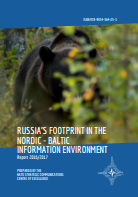RUSSIA’S GRAND STRATEGY AND ITS IMPLICATIONS ON THE INFORMATION ENVIRONMENT OF THE NORDIC-BALTIC REGION
RUSSIA’S GRAND STRATEGY AND ITS IMPLICATIONS ON THE INFORMATION ENVIRONMENT OF THE NORDIC-BALTIC REGION
Author(s): Ieva Bērziņa, Māris Cepurītis
Subject(s): Politics / Political Sciences, Politics, Media studies, Geography, Regional studies, Communication studies, International relations/trade, Security and defense, Military policy, Geopolitics
Published by: NATO Strategic Communications Centre of Excellence
Keywords: Russia; Nordic-Baltic Region; information; communication; foreign policy; military; NATO;
Summary/Abstract: The general task of the project ‘Russia’s (Dis)Information Activities Against the Nordic-Baltic Region’ is to provide an assessment of Russia’s influence on the information environment of the Nordic-Baltic countries (NB8). An analysis of the information environment requires a comprehensive understanding of the major elements of Russia’s grand strategy and their impact on the region, because the information environment reflects all major spheres of interaction between the NB8 countries and Russia. For the purpose of this study, the grand strategy is defined as the integrated use of all military and non-military means to pursue the interests of the state in the international system.4 What are Russia’s interests, and what implications do they have for the NB8 region in general—and for its information environment in particular? How do these interests translate into narratives promoted by Russia? To answer these questions, an analysis of the following documents has been conducted: Russia’s Concept of Foreign Policy (2016), Russia’s Military Doctrine (2014), Russia’s National Security Strategy (2015), and Russia’s Information Security Doctrine (2016). To understand the meaning of the documents, they are viewed in the context of actual events, research data, and the rhetoric of Russia’s top officials. The study is structured around four dimensions of analysis: political, military, economic, and informational. These dimensions cover all major power instruments that states use to advance their national interests. The political dimension includes such areas of influence as diplomacy, geopolitics, and involvement in the domestic policies of foreign states.
Book: RUSSIA’S FOOTPRINT IN THE NORDIC - BALTIC INFORMATION ENVIRONMENT
- Page Range: 16-30
- Page Count: 15
- Publication Year: 2018
- Language: English
- Content File-PDF

